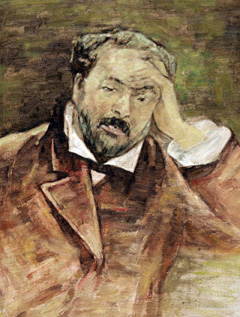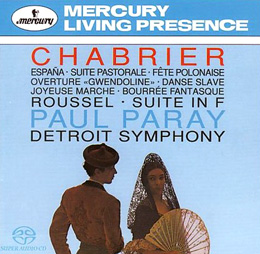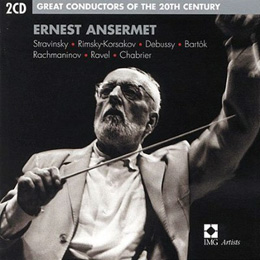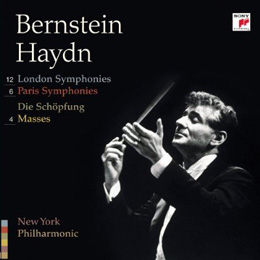| October 1, 2009
The Solid and Timeless Charm of Chabrier, Plus More
Bicentenary Haydn Reissues
 Constant Lambert’s book Music
Ho! (A Study of Music in Decline) remains in some respects as provocative now as when
it was first published, in 1934, when its author was turning 29. The book focuses
conspicuously on the works of Jean Sibelius, who was at that time just laying down his
pen, and also on an earlier composer too frequently dismissed as a lightweight, Alexis
Emmanuel Chabrier, who still needs -- and richly deserves -- some really strong advocacy. Constant Lambert’s book Music
Ho! (A Study of Music in Decline) remains in some respects as provocative now as when
it was first published, in 1934, when its author was turning 29. The book focuses
conspicuously on the works of Jean Sibelius, who was at that time just laying down his
pen, and also on an earlier composer too frequently dismissed as a lightweight, Alexis
Emmanuel Chabrier, who still needs -- and richly deserves -- some really strong advocacy.
"Above all," Lambert wrote, "Chabrier holds
one’s affection as the most genuinely French of all composers, the only writer to
give us in music the genial rich humanity, the inspired commonplace, the sunlit solidity
of the French genius that finds its greatest expression in the paintings of Manet and
Renoir [both friends of Chabrier]. There was, too, a touch of Toulouse-Lautrec about him
if we can imagine Toulouse-Lautrec without any of his sinister qualities.
"Although he unfortunately spent half his time trying
to become a French Wagner, his best work is a musical summing-up of the anti-Wagnerian
aesthetic which was not to find concrete verbal expression until much later -- in
Cocteau’s Coq et Arlequin. He was the first important composer since Mozart to
show that seriousness is not the same as solemnity, that profundity is not dependent upon
length, that wit is not always the same as buffoonery, and that frivolity and beauty are
not necessarily enemies."
 Chabrier (1841-1894) was possibly the
most remarkable French composer of his time in terms of sheer originality and of both the
breadth and the durability of his influence upon his latter-day compatriots. Like his
Russian contemporary Tchaikovsky, he was trained in law and did not take up a serious
career in music until he had held a minor post in a government ministry. Unlike
Tchaikovsky, who left his job in his early 20s to enter the St. Petersburg Conservatory
and upon graduation joined the faculty of the Moscow Conservatory (which now bears his
name), Chabrier didn’t give up his day job until he was nearly 40 years old. Chabrier (1841-1894) was possibly the
most remarkable French composer of his time in terms of sheer originality and of both the
breadth and the durability of his influence upon his latter-day compatriots. Like his
Russian contemporary Tchaikovsky, he was trained in law and did not take up a serious
career in music until he had held a minor post in a government ministry. Unlike
Tchaikovsky, who left his job in his early 20s to enter the St. Petersburg Conservatory
and upon graduation joined the faculty of the Moscow Conservatory (which now bears his
name), Chabrier didn’t give up his day job until he was nearly 40 years old.
In 1879, by which time he had established friendships with
eminent writers, painters and musicians and had become a significant figure in the
Société Nationale de Musique, Chabrier requested a leave from the Ministry of the
Interior to accompany his friend Henri Duparc (the composer of few but exquisite works, to
whom César Franck dedicated his famous Symphony in D minor) to Munich for a performance
of Tristan und Isolde. In the following year he left the Ministry to devote himself
entirely to music. His creative activity was cut off in 1892, when he suffered a general
paralysis; by the end of the following year his condition was such that he sat through the
Paris premiere of his opera Gwendoline without recognizing the music as his, and
nine months later he was dead. The works he composed within barely a dozen years, though,
constitute a pivotal factor in the renewal and continuity of French music.
That may seem an exaggerated claim on behalf of a composer
known to many people by a single work -- the brief orchestral rhapsody España --
and whom far too many others tend to put down as a mere concocter of light pieces. But the
aforementioned Gwendoline, a tragic work reflecting Chabrier’s early
fascination with Wagner, is not his only opera; his comic masterwork Le Roi malgré lui
("The King in Spite of Himself") is an absolute knockout. And when we do
have opportunities to hear his other works for orchestra, or for piano, the neglect they
have suffered over the years has to raise obvious questions.
 Chabrier’s influence is easily
enough felt in various early works of Debussy, whose Petite Suite for piano duet
finds its antecedents in Chabrier’s orchestral Suite pastorale and the ten Pièces
pittoresques from among which its four sections were chosen. César Franck described
those piano pieces as "a bridge between our own times and those of Couperin and
Rameau." Ravel acknowledged that his famous Pavane pour une Infante défunte
was written "under the spell of Chabrier," and he produced a charming Gounod
paraphrase, À la manière de Chabrier. Chabrier’s influence is easily
enough felt in various early works of Debussy, whose Petite Suite for piano duet
finds its antecedents in Chabrier’s orchestral Suite pastorale and the ten Pièces
pittoresques from among which its four sections were chosen. César Franck described
those piano pieces as "a bridge between our own times and those of Couperin and
Rameau." Ravel acknowledged that his famous Pavane pour une Infante défunte
was written "under the spell of Chabrier," and he produced a charming Gounod
paraphrase, À la manière de Chabrier.
Erik Satie more or less inherited Chabrier’s style and
expanded on it; it was he who suggested that his own disciple Darius Milhaud compose
recitatives for Chabrier’s one-act opera Une Education manqué because, as
Milhaud recorded in his autobiography, his own music bore "the stamp of
Chabrier’s style." Francis Poulenc spoke of Chabrier as his "spiritual
grandfather." The list of such acknowledgements from latter-day French musicians is
virtually endless.
Apart from those acknowledgements, and the case made by
Lambert, there is the matter of charm -- a quality that cannot be manufactured or
faked or taught. For Chabrier it was instinctive and self-renewing, and for the listener
it can be reliably therapeutic. It would be lovely if our big orchestras were to perform
his music, beyond the occasional nod to España in a "family concert" or
"pops." The conductor Raymond Leppard became a hero of mine when he included the
Suite pastorale in his début concerts with the Chicago Symphony Orchestra, and the
great conductors of earlier eras were not reluctant to perform Chabrier: The legendary
Felix Mottl, who worked with Wagner and Bruckner, made brilliant orchestral arrangements
of Chabrier’s Bourrée fantasque and his four-hand Trois Valses romantiques;
more recently, the formidable Ernest Ansermet showed his affection for Chabrier not only
in his performances and recordings, but also by naming his summer home "La
Chabrière."
Ansermet and his French contemporary Paul Paray were among
the too few conductors who not only included Chabrier in their concerts but managed to
record more of his music than the obligatory España. Paray’s collection, with
the Detroit Symphony Orchestra, is still available, I believe, because it was one of Wilma
Cozart Fine’s wonderful Mercury reissues that were remastered for three-channel SACD
(475 6183). Copies of the earlier Redbook edition (434 303-2) are probably available, too.
The contents are: España; Suite pastorale; the two dance numbers
from Le Roi malgré lui (Danse slave and Fête polonaise); the Overture to Gwendoline;
Joyeuse Marche, and Bourrée fantasque -- with Roussel’s
Suite in F as filler.
Ansermet’s elegant Chabrier assortment, recorded in
1964, comprised España, Suite pastorale, Joyeuse Marche, and
the two dances from Le Roi malgré lui. It was reissued on CD in 1992, as part of a
12-disc Ansermet series in Decca’s Jubilee series (on the London label in the U.S.
at the time: 433 720-2, together with Lalo’s Norwegian Rhapsody, Scherzo for
Orchestra, and Overture to Le Roi d’Ys), and three years later, in somewhat
smoother sound if less lively in its detail, in the "Classic Sound" series (452
890-2, with César Franck’s tone poems Le Chasseur maudit and Les Éolides).
Neither of these two Decca CDs is in the current catalogue, and even
Universal’s Eloquence label, in Australia, in its otherwise remarkable Ansermet
series, has not revived these peerless performances, though Ansermet’s 1953
monophonic versions of the two most familiar Chabrier pieces are on an Eloquence disc
otherwise devoted to music of Saint-Saëns.
 To my mind, Ansermet is simply the
most eloquent, insinuating and all-round persuasive conductor of this music, outshining
Paray and all the others who have recorded it. His account of the Fète polonaise
is simply stupendous: his tempo is broader than most, his accents and ritards
lending an infectious sense of spontaneity and utter intoxication without sacrificing a
whit of his customary elegance. Ditto for the Joyeuse Marche, and in fact for the
entire program, in which the only drawback is the inaudibility of the triangle in the
opening of the Suite pastorale. (Someone must have hit the thing, as there is a
conspicuous silence -- no music at all -- at that point.) To my mind, Ansermet is simply the
most eloquent, insinuating and all-round persuasive conductor of this music, outshining
Paray and all the others who have recorded it. His account of the Fète polonaise
is simply stupendous: his tempo is broader than most, his accents and ritards
lending an infectious sense of spontaneity and utter intoxication without sacrificing a
whit of his customary elegance. Ditto for the Joyeuse Marche, and in fact for the
entire program, in which the only drawback is the inaudibility of the triangle in the
opening of the Suite pastorale. (Someone must have hit the thing, as there is a
conspicuous silence -- no music at all -- at that point.)
But Paray on Mercury is indispensable for including the Bourrée
fantasque, and the peerless performance of the Roussel Suite -- and that elusive
triangle can be heard. As for duplicating, well, personally I am no more reluctant to the
idea of more than a single performance of a Chabrier program than to having more than a
single account of a Beethoven or Haydn symphony. But let me add here that if you
can’t find either of the Ansermet Deccas, you might look for his two-disc set in
EMI’s Great Conductors of the 20th Century series (7243 5 75094 2), which has that
incredible recording of the Fête polonaise as the final track, the true capstone,
even among works of Stravinsky, Rimsky-Korsakov, Debussy, Bartók and Ravel -- and
enhanced with a fuller and richer sound treatment than Decca managed for either of its own
CD reissues. The entire Great Conductors series has been discontinued, too, but copies are
bound to be around.
Another cut-out worth hunting for is the complete
performance of Le Roi malgré lui, with the Choeurs de Radio France and the
Nouvel Orchestre Philharmonique de Radio France, conducted by Charles Dutoit. This
was the only recording of the opera in its entirety, I believe, a two-disc set on the
Erato label, issued in 1985 (2292-45792-2) and out of print now for several years. It was
by no means a mere stopgap, but exhibited the vitality and refinement we associate with
this great conductor’s name. The cast, headed by the soprano Barbara Hendricks, the
tenor Peter Jeffes and the baritone Gino Quilico, is first-rate, and of course the Fête
polonaise makes a somewhat different kind of impression with the chorus participating.
The exemplary booklet included really valuable background as well as the full text in
French, English, and German. This is the sort of thing that ought never to go out of
circulation -- a prime example of the concept "collector’s item."
Amazon.com offers a few copies, at prices as high as $148.66; it’s time some
enterprising company got hold of this recording and made it available again at an
affordable price -- and time, too, for this work to enter the general operatic repertory.
 This raises another obvious question:
Why hasn’t Decca recorded Dutoit in a program of orchestral Chabrier? Meanwhile,
there is a slighter but still very attractive Chabrier opera among EMI’s recent
reissues: L’Étoile, in the Opera de Lyon production under John Eliot
Gardiner, in a very attractive two-disc set (0946 3 58688 2) with lots of sparkle. No text
is provided, but there is a track-by-track description of the action and the music, and
the price is roughly 10% of what Amazon.com is asking for its hard-to-find Roi malgré
lui. This raises another obvious question:
Why hasn’t Decca recorded Dutoit in a program of orchestral Chabrier? Meanwhile,
there is a slighter but still very attractive Chabrier opera among EMI’s recent
reissues: L’Étoile, in the Opera de Lyon production under John Eliot
Gardiner, in a very attractive two-disc set (0946 3 58688 2) with lots of sparkle. No text
is provided, but there is a track-by-track description of the action and the music, and
the price is roughly 10% of what Amazon.com is asking for its hard-to-find Roi malgré
lui.
Meanwhile, too, the Haydn bicentenary rolls on, and Sony
has gathered all of its Haydn recordings under Leonard Bernstein in a single space-saving
12-disc box (88697 48045 2), which arrived just too late for inclusion in our recent
consideration of the same label’s recent restoration of George Szell’s set of
the first six of the London symphonies. Included are all six Paris symphonies, all 12
London symphonies, the Symphony No. 88 in G major, the oratorio The Creation, and
four of Haydn’s very greatest settings of the Roman Catholic Mass, all of which have
specific names: the "Mass in Time of War," the "Lord Nelson Mass," the
"Harmoniemesse," and the "Theresienmesse." The orchestra is the New
York Philharmonic in all these works except two of the Masses. The Westminster Choir sang
with the Philharmonic in three of the five choral works. The "Theresienmesse"
was recorded with the London Symphony Orchestra and Chorus, the "Mass in Time of
War" with a specially assembled orchestra and the Norman Scribner Chorus in
Washington, D.C. Among the fine soloists in the various works are such excellent singers
as Judith Raskin, Judith Blegen, Lucia Popp, Gwendolyn Killebrew, Frederica von Stade,
Rosalind Elias, Alexander Young, Robert Tear, Kenneth Riegel, Michael Devlin, Alan Titus,
John Reardon, Simon Estes, and Paul Hudson.
Of special interest here are the Paris symphonies and the
four Masses, which represent both Bernstein and Haydn at their formidable best. What is
more than a little disappointing is that Sony has failed to provide even the most basic
documentation. The thin booklet offers not a word of background on the music, and the
texts for the choral works are not included. Perhaps the text of the Mass is not
considered all that essential, but surely we need the words for The Creation; Sony
doesn’t even specify whether that work is sung in German or in English: the track
listing and labeling use German titles, and that is indeed the language that is sung. The
lack of information is especially regrettable in regard to the "Mass in Time of
War," because the performance that preceded this recording was itself a fascinating
moment in recent American history. Moreover, the cardboard gatefolds in which the discs
are encased present an annoying difficulty in getting them out without harming them or the
containers; individual sleeves, or even soft envelopes, would have been ever so much more
practical in this respect. I treasure this performance of the "Harmoniemesse,"
and this recording of the "Mass in Time of War," as already acknowledged, is a
document in its own right, but opportunities -- or, one might say, basic obligations --
were missed in this presentation.
. . . Richard Freed
richardf@ultraaudio.com
|